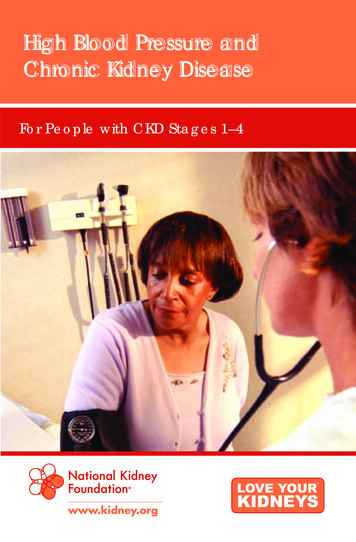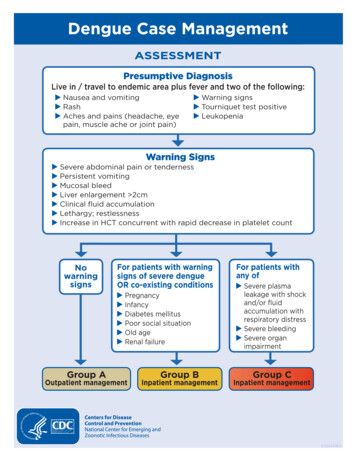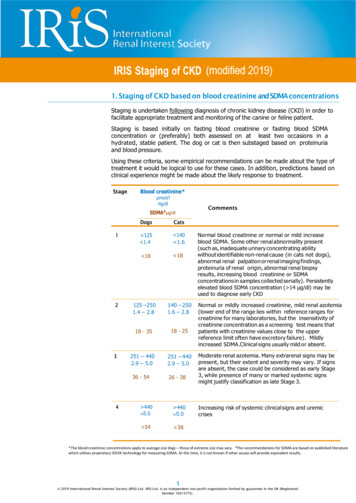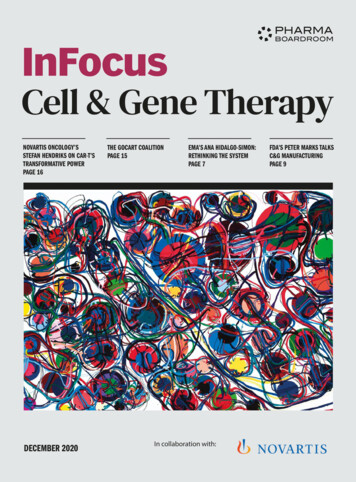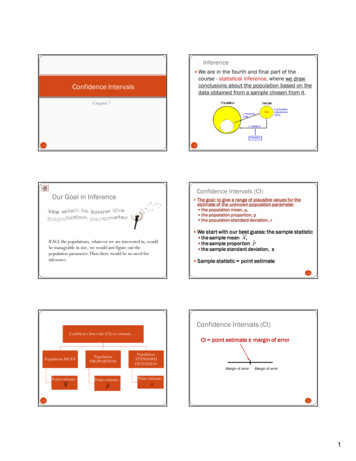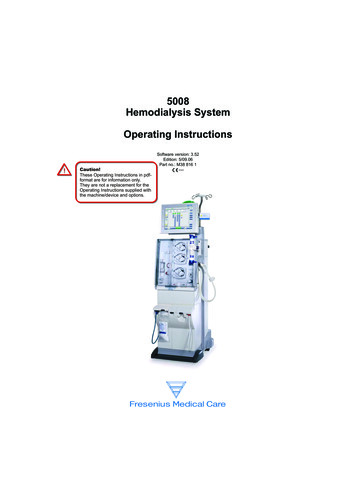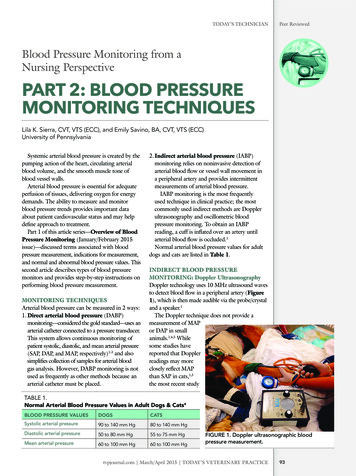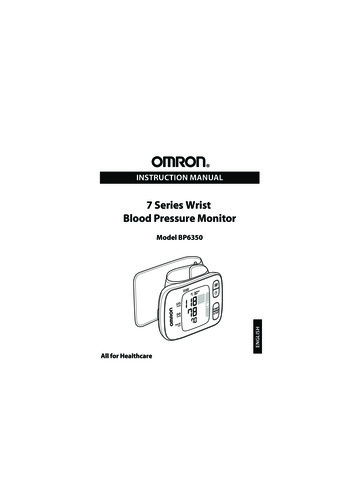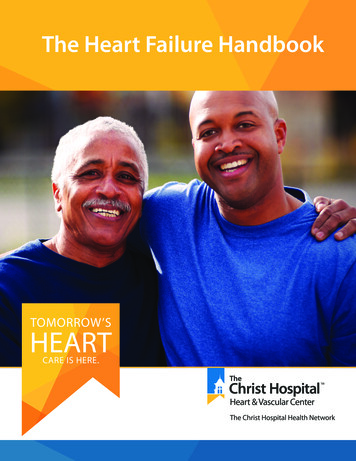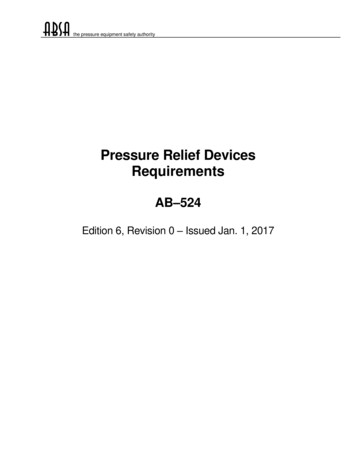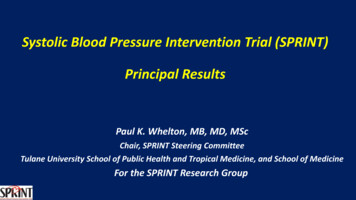
Transcription
Systolic Blood Pressure Intervention Trial (SPRINT)Principal ResultsPaul K. Whelton, MB, MD, MScChair, SPRINT Steering CommitteeTulane University School of Public Health and Tropical Medicine, and School of MedicineFor the SPRINT Research Group
Background Observational studies identify strong association between BP and risk ofCVD, with no evidence of threshold for the relationship High BP very common High SBP leading risk factor for mortality and disability-adjusted life years Worldwide, 1 billion adults have hypertension Clinical trials demonstrate antihypertensive drug therapy reduces risk of CVD However, optimal target for SBP lowering uncertain
SPRINT Research QuestionExamine effect of more intensive high blood pressure treatmentthan is currently recommendedRandomized Controlled TrialTarget Systolic BPStandard TreatmentGoal SBP 140 mm HgIntensive TreatmentGoal SBP 120 mm HgSPRINT design details available at: ClinicalTrials.gov (NCT01206062) Ambrosius WT et al. Clin. Trials. 2014;11:532-546.
Major Inclusion Criteria 50 years old Systolic blood pressure : 130 – 180 mm Hg (treated or untreated) Additional cardiovascular disease (CVD) risk Clinical or subclinical CVD (excluding stroke) Chronic kidney disease (CKD), defined as eGFR 20 – 60 ml/min/1.73m2At least one Framingham Risk Score for 10-year CVD risk 15% Age 75 years
Major Exclusion Criteria Stroke Diabetes mellitus Polycystic kidney disease Congestive heart failure (symptoms or EF 35%) Proteinuria 1g/d CKD with eGFR 20 mL/min/1.73m2 (MDRD) Adherence concerns
Location of 102 SPRINT Clinical CentersClinical Center Networks-Ohio -Southeast -Utah-UAB-VACentral LaboratoryMRI Reading CenterProject Office, NIHCoordinating CenterWake Forest School of MedicineECG Reading CenterDrug Distribution Center
SPRINT: Enrollment and Follow-up ExperienceScreened(N 14,692)Randomized(N 9,361) Consent withdrawn Discontinued intervention Lost to follow-upAnalyzed(Intention to treat)IntensiveTreatmentStandardTreatment(N 4,678)(N 4,683)1542241111212421344,6784,683(Vital status assessment: entire cohort)
Demographic and Baseline CharacteristicsMean (SD) age, years% 75 yearsFemale, %White, %African-American, %Hispanic, %Prior CVD, %Mean 10-year Framingham CVD risk, %Taking antihypertensive meds, %Mean (SD) number of antihypertensive medsMean (SD) Baseline BP, mm HgSystolicDiastolicTotalN 9361IntensiveN 4678StandardN 468367.9 (9.4)28.2%35.6%57.7%29.9%10.5%20.1%20.1%90.6%1.8 (1.0)67.9 (9.4)67.9 10.3%20.1%20.0%20.1%20.1%90.8%90.4%1.8 (1.0)1.8 (1.0)139.7 (15.6)78.1 (11.9)139.7 (15.8)139.7 (15.4)78.2 (11.9)78.0 (12.0)
Selected Baseline Laboratory CharacteristicsMean (SD) eGFR, mL/min/1.73 m2% with eGFR 60 mL/min/1.73m2Mean (SD) Urine albumin/creatinine, mg/gMean (SD) Total cholesterol, mg/dLMean (SD) Fasting plasma glucose, mg/dLTotalN 936171.7 (20.6)28.342.6 (166.3)190.1 (41.2)98.8 (13.5)IntensiveN 4678StandardN 468371.8 (20.7)71.7 (20.5)28.428.144.1 (178.7)41.1 (152.9)190.2 (41.4)190.0 (40.9)98.8 (13.7)98.8 (13.4)
Pre-specified Subgroups of Special Interest Age ( 75 vs. 75 years) Gender (Men vs. Women) Race/ethnicity (African-American vs. Non African-American) CKD (eGFR 60 vs. 60 mL/min/1.73m2) CVD (CVD vs. no prior CVD) Level of BP (Baseline SBP tertiles: 132, 133 to 144, 145 mm Hg)-
Primary Outcome and Primary Hypothesis Primary outcome CVD composite: first occurrence of Myocardial infarction (MI) Acute coronary syndrome (non-MI ACS) Stroke Acute decompensated heart failure (HF) Cardiovascular disease death Primary hypothesis* CVD composite event rate lower in intensivecompared to standard treatment*Estimated power of 88.7% to detect a 20% difference- based on recruitment of 9,250 participants, 4-6 years of follow-up and loss to follow-up of 2%/year.
Additional Outcomes All-cause mortality Primary outcome all-cause mortality Renal Main secondary outcome: Participants with CKD at baseline: incidence of decline in eGFR 50% or ESRD Additional secondary outcomes: Participants without CKD at baseline: incidence of decline in eGFR 30% (to 60 mL/min/1.73m2) Participants with or without CKD at baseline: Incidence of albuminuriaDoubling of urinaryalbumin/creatinine( 10 to 10 mg/g)
Follow-up Assessment of Selected Measures CVD outcomes Pre-specified diagnostic criteria Ascertainment method identical in both treatment arms Structured interview every 3 months Possible events adjudicated by a panel of experts, blinded to treatment assignment Fatal events Structured approach to collection of information Cause of death adjudicated by the panel of experts, blinded to treatment assignment Safety events Could be reported at any SPRINT visit Observers aware of treatment assignment Labs: blood chemistries and urine albumin/creatinine
BP Intervention BP monitored monthly for 3 months and every 3 months thereafter(additional visits could be scheduled) Antihypertensive medication titration decisions based on mean BP(3 readings at each visit), using a structured stepped-care approach Agents from all major antihypertensive drug classes available free of charge Periodic assessment for orthostatic hypotension and related symptoms
SPRINTTreatmentAlgorithmIntensiveTreatment
SPRINTTreatmentAlgorithmStandardTreatment
Systolic BP During Follow-upYear 1Average SBPMean SBP136.2 mm Hg(During Follow-up)Mean SBP121.4 mm HgStandardIntensiveStandard: 134.6 mm HgIntensive: 121.5 mm HgAverage number ofantihypertensivemedicationsNumber ofparticipants
Decision to Stop BP Intervention On August 20th, 2015, NHLBI Director accepted DSMB recommendation to inform SPRINTinvestigators and participants of CVD results Concurrently, decision made to stop BP intervention This presentation based on adjudicated events that occurred through August 20th, 2015 Median follow-up 3.26 years Data for some secondary non-CVD outcomes (e.g. dementia and cognitive impairment)being collected at final close-out visit and this process will be completed in 2016
SPRINT Primary OutcomeCumulative HazardHazard Ratio 0.75 (95% CI: 0.64 to 0.89)Standard(319 events)Intensive(243 events)During Trial (median follow-up 3.26 years)Number Needed to Treat (NNT)to prevent a primary outcome 61Number ofParticipants
SPRINT Primary Outcome and its ComponentsEvent Rates and Hazard RatiosIntensiveStandardNo. of Events Rate, %/year No. of Events Rate, %/year HR (95% CI)P valuePrimary Outcome2431.653192.190.75 (0.64, 0.89) 0.001All MI970.651160.780.83 (0.64, 1.09) 0.19Non-MI ACS400.27400.271.00 (0.64, 1.55) 0.99All Stroke620.41700.470.89 (0.63, 1.25) 0.50All HF620.411000.670.62 (0.45, 0.84) 0.002CVD Death370.25650.430.57 (0.38, 0.85) 0.005
Primary Outcome Experience in the Six Pre-specified Subgroups of Interest*Treatment by subgroup interaction
All-cause MortalityCumulative HazardHazard Ratio 0.73 (95% CI: 0.60 to 0.90)Standarddeaths)Adapt from Figure 2B in the(210N EnglJ Med manuscriptIntensive(155 deaths)During Trial (median follow-up 3.26 years)Number Needed to Treat (NNT)Include NNTto Prevent a death 90Number ofParticipants
All-cause Mortality Experience in the Six Pre-specified Subgroups of Interest**p 0.34, after Hommeladjustment for multiplecomparisons
Renal Disease OutcomesIntensiveStandardEvents%/yrEvents%/yrHR (95% CI)P140.33150.36 0.89 (0.42, 1.87) 0.7610600.230.14-111000.260.24-0.87 (0.36, 2.07)0.57 (0.19, 1.54)-0.750.27.493.02593.900.72 (0.48, 1.07)0.111271.21370.353.48 (2.44, 5.10) .0001Participants with CKDat BaselinePrimary CKD outcome 50% reduction in eGFR*DialysisKidney transplantSecondary CKD OutcomeIncident albuminuria**Participants withoutCKD at BaselineSecondary CKD outcomes 30% reduction in eGFR*Incident albuminuria**1102.001352.41 0.81 (0.63, 1.04) 0.10*Confirmed on a second occasion 90 days apart **Doubling of urinary albumin/creatinine ratio from 10 to 10 mg/g
Serious Adverse Events* (SAE) During Follow-upAll SAE reportsNumber (%) of ParticipantsIntensiveStandardHR (P Value)1793 (38.3) 1736 (37.1)1.04 (0.25)SAEs associated with Specific Conditions of InterestHypotensionElectrolyte abnormality110 (2.4)107 (2.3)105 (2.2)87 (1.9)144 (3.1)66 (1.4)80 (1.7)110 (2.3)73 (1.6)107 (2.3)1.67 (0.001)1.33 (0.05)0.95 (0.71)1.19 (0.28)1.35 (0.020)Acute kidney injury or acute renal failure193 (4.1)117 (2.5)1.66 ( 0.001)SyncopeInjurious fallBradycardia*Fatal or life threatening event, resulting in significant or persistent disability,requiring or prolonging hospitalization, or judged important medical event.
Number (%) of Participants with aMonitored Clinical Measure During Follow-upNumber (%) of ParticipantsIntensiveStandardHR (P Value)Laboratory Measures1Sodium 130 mmol/LPotassium 3.0 mmol/LPotassium 5.5 mmol/l180 (3.9)114 (2.5)176 (3.8)100 (2.2)74 (1.6)171 (3.7)1.76 ( 0.001)1.50 (0.006)1.00 (0.97)Signs and SymptomsOrthostatic hypotension2Orthostatic hypotension with dizziness777 (16.6) 857 (18.3)62 (1.3)71 (1.5)0.88 (0.013)0.85 (0.35)1. Detected on routine or PRN labs; routine labs drawn quarterly for first year, then q 6 months2. Drop in SBP 20 mmHg or DBP 10 mmHg 1 minute after standing (measured at 1, 6, and 12 months and yearly thereafter)
Summary and Conclusions SPRINT examined effects of more intensive antihypertensive therapy than currently recommended Participants were US adults 50 years with hypertension and additional risk for CVD Rapid and sustained difference in SBP achieved between the two treatment arms Trial stopped early, due to benefit, after median follow-up of 3.26 years Incidence of primary outcome (composite of CVD events) 25% lower in Intensive compared toStandard Group and all-cause mortality reduced by 27%. Treatment effect similar in all six pre-specified groups of interest. The “number needed to treat” to prevent primary outcome event or death 61 and 90, respectively
Summary and Conclusions In participants with CKD at baseline, no differences in renal outcomes In participants without CKD at baseline, incidence of eGFR reduction 30% morecommon in Intensive Group No overall difference in serious adverse events (SAEs) between treatment groups SAEs associated with hypotension, syncope, electrolyte abnormalities, and hospitaldischarge reports of acute kidney injury or acute renal failure more common inIntensive Group Overall, benefits of more intensive BP lowering exceeded the potential for harm
Acknowledgements 9,361 volunteers who agreed to participate in SPRINT Investigators and staff, including Steering Committee, other principals at the 5 ClinicalCenter Networks, 102 participating Clinical Centers, Coordinating Center, CentralLaboratory, ECG Reading Center, MRI Reading Center, and Drug Distribution Center National Institutes of Health National Heart, Lung, and Blood Institute (NHLBI)National Institute of Diabetes and Digestive and Kidney Diseases (NIDDK)National Institute on Aging (NIA)National Institute of Neurological Disorders and Stroke (NINDS) SPRINT Data and Safety Monitoring Board (DSMB) Takeda and Arbor Pharmaceuticals (donated 5% of medication used)
Thank YouAdditional details of the SPRINT principal resultsThe SPRINT Research GroupA Randomized Trial of Intensive versus Standard Blood-Pressure ControlN Engl J Med. DOI: 10.1056/NEJMoa 1511939(simultaneous e publication)
SPRINT Timeline Planning: September 2009 Start Recruitment: November 2010 End Recruitment: March 2013 Intervention Stopped: August 2015 Announcement of Preliminary Main Results: September 2015 Presentation & Publication of Main Results: November 2015 Anticipated Completion of Close-out Visits: 2016
Decision to Stop BP Intervention On August 20th, 2015, NHLBI Director accepted DSMB recommendation to inform SPRINT investigators and participants of CVD results Concurrently, decision made to stop BP intervention This presentation based on adjudicated events that occurred through August 20th, 2015 Median follow-up 3.26 years Data for some secondary non-CVD outcomes (e.g .
